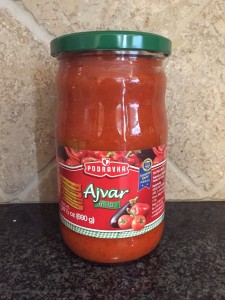Things have been quiet here on the blog as I finished the first draft of my 13th novel, Rattlesnake. I also had two laptop meltdowns and a traumatic phone upgrade, all of which have sucked away far too much of my time. I’m planning a (probably quarterly) newsletter in the near future, with excerpts, free stories, updates, contests, etc. You can sign up using the form off to the right or by going here: http://eepurl.com/bau3S9.
So let’s talk about ajvar.
It’s pronounced ahy-vahr. I believe it’s native to Serbia, but it’s also very commonly eaten in Croatia, where I’ve lived. It’s made of roasted red peppers, eggplant, and spices, and is used as a relish or spread. I like it on a sandwich or on roast chicken, or just eaten beside the main course. You can get it in varying degrees of sweetness and spiciness. My small neighborhood groceries in Zagreb always had a large selection, but since my understanding of the language is rudimentary, I usually just chose a jar at random. A lot of people make their own, and I can tell you that homemade ajvar is especially delicious.
Unless you have a Balkan grocery store near you, ajvar is fairly hard to come by outside of that region. I did see some jars of Bulgarian ajvar during my last trip to CostPlus, an import store here in California. The jar in the photo is a Croatian brand.
If you’re not familiar with foods from the region, I’d describe ajvar as sort of like salsa or chutney, but not quite.Which gets me thinking about foods that are specific to a place and hard for anyone else to understand. Like peanut butter. Although it’s a sandwich staple in the US, every European I’ve spoke to finds the concept odd. (I tell them it’s sort of like Nutella minus the chocolate, but that doesn’t help much.) Ketchup is apparently mysterious in some places too. Once, when I was in Ljubljana, Slovenia, our waiter sussed out that we were Americans and proudly brought us a bottle of ketchup. We were eating pizza.
I think nearly every place has some food like this–something beloved to the locals but puzzling or unknown to everyone else. What are some of the foods like this in your region?



I live in Italy, not far from Slovenia, and ajvar can be found in some supermarkets. As for the peanut butter, I’ve seen it in the major supermarket chains but I’ve never tried it.
You should try peanut butter! Peanut butter toast is one of my comfort foods. Do you eat ajvar and if so, do you have a favorite variety?
When I think of northern Italian food, I think of figs. My grandfather was from Trieste and in the US, he always wanted a fig tree. Americans eat figs but not very often, and rarely fresh, which is too bad.
I prefer mild over hot. We usually eat it with grilled meat or cevapcici. I’ll definitely try peanut butter.
I don’t eat cevapcici because I don’t eat red meat, but I know you can’t have cevap without ajvar. 🙂
I think in the UK we get practically everything. I love peanut butter toast too. Fresh figs are also a delight when in season. I haven’t come across the Ajvar yet but no doubt will as a lot of eastern european shops are popping up lately, Polish being one of the popular ones (they used to make amazing jams). Having said that I am not keen on peppers, I was given a jar of pepper and tomato chutney as a gift and sadly ended up throwing it away.
I’ve been to Poland a couple of times and especially loved pierogie and borscht.
Maybe you’d like ajvar since the peppers are roasted–it gives them a different taste.
Here’s how an old Portuguese farmer told me to do fresh figs: slice them in half, drizzle on a tiny bit of honey, sprinkle blue cheese, then microwave for about 10 seconds–just enough to warm them. Yum!
My favorite UK food? Curly Wurlys. 🙂
Ajvar is sold everywhere in Denmark. As for odd food I’d say pickled herring, canned mackerel in tomatosauce (yum), liver pâté, blood sausage and the fact that we eat cracklings with much gusto. We’re pigs.
Hey, I’ve eaten chicken feet. 🙂 And my Polish grandfather loved pickled herring. Me… not so much. 🙂
I know there’s a large Bosnian ex-pat community in Sweden. Are there a lot of Denmark too? That could explain the ajvar.
App 20,000 from Bosnia live in Denmark. Very well integrated. Fewer and fewer Danes cook traditional Danish food on a daily basis and try for Southern European, and Asian foods instead. More vegetables, better taste than pork, herring, potatoes and gravy which was what we used to eat because we had no vegetables other than potatoes, carrots, peas, green beans, leeks and yellow onions. More or less. Chicken feet? Eew.
So I bet you can find burek. Yummy! Southern European and Asian cuisines are good choices. 🙂 Chicken feet taste pretty good, actually. But they look like chicken feet.